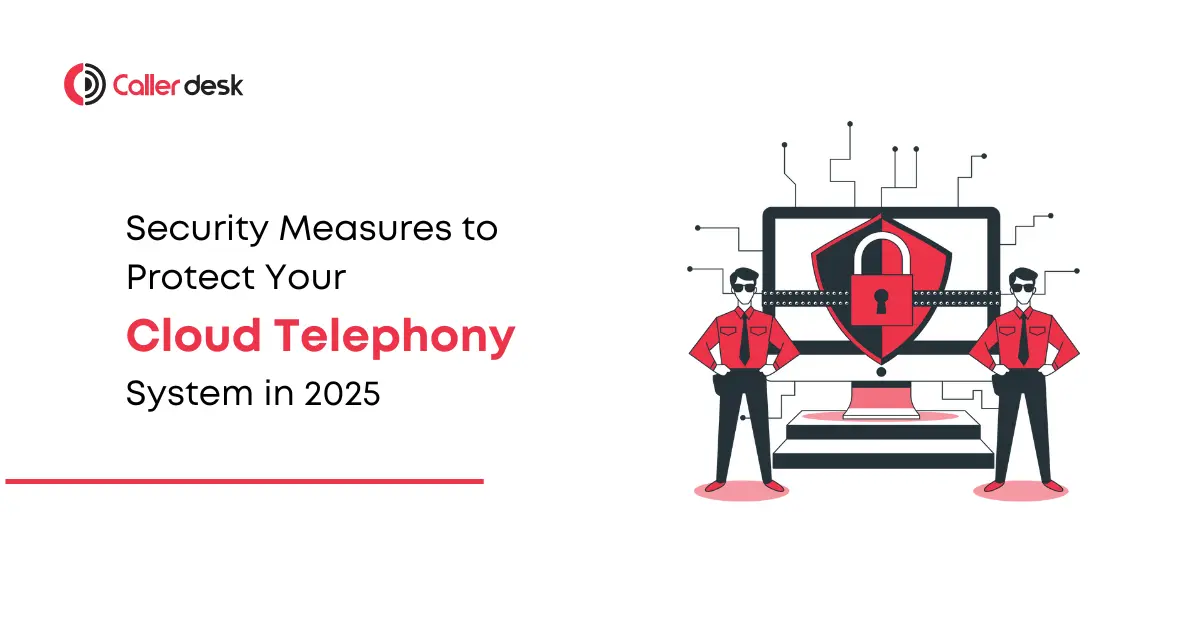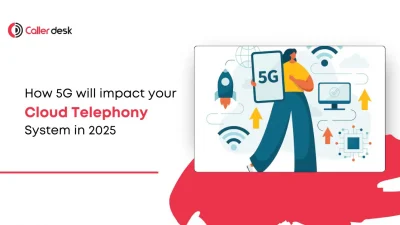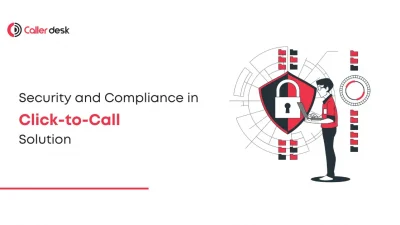Is Your Cloud Telephony System Ready for 2025?
In 2025, businesses relying on cloud telephony system will face increasingly sophisticated cyber threats. Whether it’s data breaches, social engineering attacks, or emerging technologies like AI-powered threats, securing your business communication systems is non-negotiable.
Consider this: A single breach could mean data leaks, non-compliance fines, loss of trust, and disrupted operations.
This guide outlines top security measures to fortify your cloud telephony system, from encryption and role-based controls to proactive monitoring and user education. Let’s explore how you can stay ahead of these threats and ensure secure, seamless operations for your business.
1. Multi-Factor Authentication (MFA): Adding Layers of Protection
Passwords can no longer stand alone against modern threats. Multi-Factor Authentication (MFA) strengthens security by adding extra verification steps.
How MFA Works:
- Primary Password: The user enters their account password.
- Secondary Verification: A unique code sent via SMS, an authentication app (e.g., Google Authenticator), or biometric methods like fingerprint scans.
Benefits:
- Even if credentials are compromised, access is still blocked.
- Reduces risks from phishing, credential stuffing, and brute-force attacks.
Example Use Case:
A global contact center adopted MFA for their cloud telephony accounts. During a phishing attempt targeting employee logins, MFA prevented unauthorized access, securing critical client communications.
2. End-to-End Encryption: Safeguarding Communications
End-to-end encryption (E2EE) protects voice calls, text messages, and file transfers by converting data into unreadable ciphertext. Only authorized users with the decryption keys can access it.
AES-256 Encryption: The Gold Standard
- AES-256 (Advanced Encryption Standard) provides military-grade protection that is virtually impossible to crack.
- It’s ideal for industries like finance, healthcare, and e-commerce where sensitive data is transmitted daily.
Why It’s Essential:
- Prevents interception by cybercriminals or unauthorized parties.
- Ensures compliance with regulations like GDPR and HIPAA.
Visual Aid:
Include a diagram showing the encryption flow: Voice/Data → Encrypted during Transmission → Decrypted at Destination.
3. Role-Based Access Control (RBAC): Limiting User Privileges
Role-Based Access Control (RBAC) ensures employees only access the information and functionalities they need to perform their jobs.
How RBAC Works in Cloud Telephony:
- Agents: Can access live call logs and basic customer information.
- Supervisors: Can monitor agent calls, access analytics, and configure limited settings.
- Administrators: Have full access to system configurations, data, and audit logs.
Best Practices for Implementing RBAC:
- Use the principle of least privilege (PoLP) to minimize access.
- Regularly review and update user permissions.
- Implement temporary role escalation for specific projects or emergencies.
Example Use Case:
A contact center implemented RBAC to restrict agents from exporting call logs. Only managers could download reports, preventing unauthorized sharing of sensitive customer data.
Visual Aid:
A chart showing different user roles, their permissions, and access boundaries in a cloud telephony system.
4. User Education and Training: Strengthening Human Defenses
While technical measures are critical, employees remain the first line of defense against cyberattacks. Many breaches occur due to human errors like weak passwords or falling for phishing scams.
Key Training Areas:
- Recognizing Phishing Attempts: Teach employees to identify suspicious emails, links, and messages.
- Avoiding Social Engineering Attacks: Help staff recognize manipulation tactics used by attackers.
- Password Hygiene: Enforce strong, unique passwords and regular updates.
- Safe Usage Policies: Guide employees on safe practices when using cloud telephony tools.
Pro Tip: Simulate phishing attacks quarterly to test and improve employee awareness.
Example:
An insurance firm reduced phishing-related incidents by 60% after implementing regular security awareness training for employees.
5. Routine Security Audits and Vulnerability Scans: Proactive Risk Management
Security audits and vulnerability scans are critical for identifying weaknesses before they’re exploited.
Tools to Conduct Vulnerability Scans:
- Nessus: Popular for in-depth vulnerability detection.
- OpenVAS: Open-source tool for real-time scans.
- Qualys: Offers automated cloud-based security assessments.
Benefits of Routine Audits:
- Identify outdated configurations and patch vulnerabilities.
- Ensure compliance with PCI DSS, GDPR, and HIPAA standards.
- Strengthen system defenses against new and emerging threats.
Example:
A retail business identified weak firewall configurations during a routine vulnerability scan. Immediate action prevented potential unauthorized access to their call logs.
Visual Aid:
An infographic illustrating the audit process: Scan → Detect Vulnerabilities → Patch → Validate Security Improvements.
6. Emerging Threats: Preparing for Tomorrow’s Challenges
The cybersecurity landscape is evolving. Businesses must anticipate and defend against emerging threats like:
AI-Powered Cyberattacks
- Attackers now use AI to automate phishing campaigns and mimic real communication.
- Solution: Implement AI-based threat detection tools to identify and block suspicious activity.
Quantum Computing Risks
- Quantum computers could potentially crack encryption algorithms like AES.
- Solution: Begin transitioning to post-quantum cryptography, which provides future-proof encryption methods.
Pro Tip: Partner with security experts to stay ahead of emerging risks and develop long-term strategies.
7. Data Masking and Anonymization: Ensuring Privacy Compliance
Data masking and anonymization techniques help protect sensitive customer data during transmission and storage.
Techniques to Use:
- Tokenization: Replace sensitive data with unique tokens.
- Shuffling: Rearrange data values to make them unrecognizable.
- Format-Preserving Encryption (FPE): Retain data structure while encrypting the content.
Real-World Example:
A global telecom provider anonymized customer contact data in their cloud telephony logs, ensuring compliance with GDPR without disrupting daily operations.
Conclusion
Securing your cloud telephony system isn’t just about following protocols—it’s about safeguarding customer trust, ensuring business continuity, and preparing for future challenges.
Key Takeaways:
- Implement MFA, end-to-end encryption, and RBAC to fortify security.
- Conduct regular audits and educate employees to minimize risks.
- Stay ahead of AI-powered threats and invest in post-quantum encryption for future-proof security.
At CallerDesk, we prioritize your communication security with industry-leading cloud telephony solutions. We’re committed to helping you protect sensitive data, comply with regulations, and stay resilient in the face of evolving cyber threats.
Call to Action:
Ready to Secure Your Cloud Telephony System?
Contact CallerDesk today to schedule a free consultation or demo. Discover how our secure, compliant cloud telephony solutions can safeguard your business communication in 2025 and beyond.
[Schedule Your Demo Now]
Frequently Asked Questions
1. What is the importance of Multi-Factor Authentication (MFA) for cloud telephony?
MFA adds an extra layer of security by requiring additional verification steps, preventing unauthorized access even if passwords are compromised.
2. How does end-to-end encryption secure cloud telephony systems?
End-to-end encryption ensures that only the sender and the intended recipient can access data, protecting it from interception or eavesdropping.
3. What is role-based access control (RBAC) in cloud telephony?
RBAC limits system access based on user roles and responsibilities, reducing internal security risks and accidental data exposure.
4. Why are security audits important for cloud telephony systems?
Regular security audits identify vulnerabilities, ensure compliance, and prevent security breaches before they happen.
5. What security standards should businesses follow for cloud telephony?
Businesses should comply with frameworks like PCI DSS, GDPR, and CCPA to ensure data protection and avoid penalties.





